Butterflies and Moths in Nabokov's Published Writings
Alphabetical Order ‒ Page 9
... Pl ... * Po-Py * ... Q ...
Poanes aaroni Skinner, 1890 [Hesperiidae, Hesperiinae]: Aaron's Skipper, Saffron Skipper or Atlantic Marsh Skipper. This is a tawny-orange N American skipper with a dark margin. The wingspan is 25–38 mm. The species was described from Cape May, New Jersey, in 1890. Its habitat is salt marshes along the Atlantic coast from New Jersey to Florida.
*SelLet 327
Poanes zabulon Boisduval & Leconte, 1834 [Hesperiidae]: the Zabulon Skipper, from Massachusetts W to Wisconsin and S to Texas and Georgia.
*NabBut 398 (L)
Polar Fritillary: »Clossiana polaris
Polites coras Cramer, 1775, syn peckius Kirby, 1836 [Hesperiidae, Hesperiinae]: Peck's Skipper, from SE Canada south to Georgia and westward to British Columbia, Oregon, Montana, Colorado and Arizona.
*NabBut 398 (L); Lep16
Polites mystic W.H. Edwards, 1863 [Hesperiidae, Hesperiinae]: the Long Dash, from Washington State to New Jersey and north into Canada.
*NabBut 398 (L)
Polites peckius: »Polites coras
Polites sonora utahensis Skinner, 1911 [Hesperiidae, Hesperiinae]: the Utah Skipper, a subspecies of the Sonora Skipper, from British Columbia to S Nevada and Baja California.
*StrOps 324; Lep16
Polygonia Hübner, 1819: a Holarctic genus of »Nymphalidae, subfamily Nymphalinae, tribe Nymphalini (anglewings). It is characterized by its ragged wing edges. The type-species is Polygonia c-aureum Linnaeus, 1758.
*SelLet 368
Polygonia c-album (Lampert 1907)
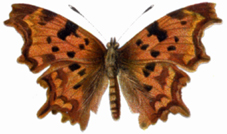
Polygonia c-album Linnaeus, 1758 [Nymphalidae]: the Comma Butterfly. See under »anglewing.
*Stor:MlleO 482; SpeakM 106; Lep1 31; Lep2 256, 268
Polygonia faunus W.H. Edwards, 1862 [Nymphalidae]: the Green Comma, from N Georgia through New York State to Hudson Bay, then west through Canada to Vancouver Island and Northwest Territories and S to C California.
*NabBut 398 (L)
Polygonia progne Cramer, 1776 [Nymphalidae]: the Gray Comma, from Nova Scotia to Virginia and North Carolina and west to Kansas and Nebraska.
*NabBut 398 (L)
Polygonia silvius W.H. Edwards, 1874 [Nymphalidae]: a N American anglewing Nabokov encountered in spring, 1959 during his Oak Creek Canyon outing with Robert H. Boyle. He commented, "This one is an Angle Wing. It has a curiously formed letter C. It mimics a chink of light through a dead leaf. Isn't that wonderful? Isn't that humorous?"
*Int1 129 (NabBut 534)
& Ac: Polygónia sílvius • Am: Sylvan Anglewing
Polygonia thaïsoides Nab.: "the thais-like anglewing", an imaginary butterfly Nabokov drew for his wife in a copy of Lolita. Polygonia is an existing genus of Nymphalidae, Nymphalinae, Nymphalini, and thais is a marine snail.
*Véra's Butterflies, p. 269
polyommatine: any member of the subfamily Polyommatinae (blues) of »Lycaenidae.
Polyommatus Latreille, 1804: a genus of »Lycaenidae, subfamily Polyommatinae (blues), tribe Polyommatini, Polyommatus Section. The type-species is »Polyommatus icarus. The name means 'the many-eyed one,' a reference to the many small eye-spots on the underside.
*Lep9 48
Polyommatus Section: a genus-group within the tribe Polyommatini of the subfamily Polyommatinae (blues) in the »Lycaenidae, as proposed by John Nevil »Eliot in 1973. The Polyommatinae are made up of at least 109 genera; of these, most (99) are Polyommatini. Eliot's Polyommatus Section had 33 genera with about 100 species. After its reformation by Bálint & Johnson (1997), the Polyommatus Section has 404 species worldwide, grouped in nine genera (Agriades, Albulina, Aricia, Chilades, Madeleinea, Paralycaeides, Plebejus, Polyommatus and Pseudolucia).
Eliot's Polyommatus Section was "actually identical with Nabokov's Polyommatine subfamily Plebejinae" (Bálint & Johnson 1997). For comparison, the list of »Plebejinae Nabokov drew up at the end of Lep9 had 24 genera with 100 to 120 species worldwide. Of these, Bálint & Johnson threw out six because they belonged to different lineages (in technical language, the original Polyommatus Section was polyphyletic).
That is, the basis has widened, even though a number had to be dismissed from the group – many more species have been identified than in Nabokov's and Eliot's times. On the other hand, the number of genera has shrunk considerably, and the few remaining ones are much larger.
Polyommatus (ex Agrodiaetus) ainsae Forster, 1961 [Lycaenidae]: Forster's Furry Blue, locally in N Spain, provinces of Burgos, Alava and Huesca (Ainsa and Jaca), in dry, bushy and grassy places at altitudes between 950 and 1,200 m. The chromosome number is 108 and helps to distinguish it from the Furry Blue (Polyommatus dolus) in N Spain, S France and C Italy that has a chromosome count of 124. It can also be distinguished morphologically as it originally was by its author: it is smaller, its blue is lighter, and there are white blots on the hindwings underneath. The distinction from neighboring taxa is so strong that ainsae has since been accorded specific rank. See also in the »Introduction.
*StrOps 332
& Ac: Polyómmatus aínsae • En: Forster's Furry Blue • Fr: le sablé basque • Ge: *Ainsa-Bläuling
Polyommatus (ex Lysandra) albicans Herrich-Schäffer, 1851 [Lycaenidae]: the Spanish Chalk-hill Blue, in Morocco and Spain.
*Lep4 266
Polyommatus amandus: »Polyommatus icarius
Polyommatus bellargus m + f (Lampert 1907)

Polyommatus (ex Lysandra, Agrodiaetus, Agriades, Lycaena) bellargus Rottemburg, 1775 [Lycaenidae]: a blue with a wingspan of 27–32 mm flying in the warmer parts of C and S Europe, in S Russia, Iraq and Iran. The males are bright celestial azure with a narrow white fringe, the females are brown.
*StrOps 60; LookHarl 156; NabBut 211 (FB), 577 (BE); Lep1 30; Lep2 268
& Ac: Polyómmatus/Lysándra/Agrodiáetus/Agríades/Lycáena bellárgus • En: Adonis Blue, old English common name Clifden Blue • Fr: l'argus bleu céleste, le bel argus • Ge: Himmelblauer Bläuling, Adonis • Ru: голубянка красивая, голубянка Беларгус, (DarII) адонис • Sp: niña celeste
Polyommatus bellargus vestae Verity [Lycaenidae]: a particularly puny "race" of the Adonis Blue on the Isle of Wight.
*NabBut 608 (BE)
Polyommatus coridon (Lampert 1907)
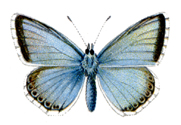
Polyommatus (ex Lysandra, Agriades, Lycaena) coridon Poda, 1761 [Lycaenidae]: a European blue with a wingspan of 30 to 35 mm. The males are a light silvery blue with dark borders, the females are brown. This was the next to last butterfly Nabokov captured in 1975. See also »Erebia eriphyle.
*Lep4; LtVé 390
& Ac: Polyómmatus/Lysándra/Agríades/Lycáena corídon • En: Chalk-hill Blue • Fr: l'argus bleu nacré • Ge: Silbergrüner Bläuling • It: licenide argentea • Ru: голубянка Коридон, голубянка серебристая • Sp: niña coridon
Polyommatus (ex Agrodiaetus) damon Denis & Schiffermüller, 1775 [Lycaenidae]: the Damon Blue, found in isolated colonies in S, C and E Europe, Turkey, S and C Urals, Altai, Mongolia.
*Lep9 42, 46, 48
Polyommatus daphnis (Lampert 1907)
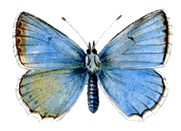
Polyommatus (ex Meleageria, Plebejus, Agriades) daphnis Denis & Schiffermüller, 1775, syn meleager Esper, 1779 [Lycaenidae]: a blue with a wingspan of 30– 35 mm. The range is S and SE Europe, S Russia, Turkey, Near East, Iran, Transcaucaus, S Urals. The males are a bright azure, the females brown with much blue on the hindwings and some on the lower part of the forewings.
*SpeakM 274; SelLet 437; NabBut 210 (FB); Lep1 30, Lep4 266
& Ac: Polyómmatus/Meleagéria/Plebéjus/Agriádes dáphnis/meléager • En: Meleager's Blue • Fr: l'azuré de l'orobe • Ge: Braungefleckter Bläuling, Zahnflügelbläuling • Ru: голубянка Дафнис, Мелеагр • Sp: azul bipuntada
Polyommatus (ex Agrodiaetus) dolus Hübner, 1823 [Lycaenidae]: a blue from in N Spain, S and SW France and NW Italy and the Apennines, with a wingspan of c. 35 mm and a gray underside, flying on flowery meadows in hilly country, from 500 to 1,500 m.
*StrOps 332
& Ac: Polyómmatus/Agrodiáetus dólus • En: Furry Blue • Fr: le sablé de lucerne • Ge: Grünblauer Bläuling • Sp: velludita fimbria clara
Polyommatus (ex Plebicula) dorylas Denis & Schiffermüller, 1775, hom hylas Esper, 1775 [Lycaenidae]: the Turquoise Blue, flying in S and C Europe, Turkey, Transcaucasia.
*Lep2 270
Polyommatus eros Ochsenheimer, 1808 [Lycaenidae]: a blue with a wingspan of 25–30 mm, in the Alps and Pyrenees, the Apennines and Balkans, in NW and C Asia, on mountain meadows between 1,200 and 2,500 m. The males are blue with dark margins, the females all brown.
*StrOps 333; Lep4 265
& Ac: Polyómmatus éros • En: Eros Blue • Fr: l'azuré de l'oxytropide • Ge: *Eros-Bläuling • Sp: niño amoroso
Polyommatus (ex Plebicula, Lycaena) escheri Hübner, 1823 [Lycaenidae]: a blue, in Morocco, Spain, Italy and S Balkans.
*NabBut 208 (FB); Lep4 266, 267
& Ac: Polyómmatus éscheri • En: Escher's Blue • Fr: l'azuré du plantain • Ru: (DarII) голубянка Эшера
Polyommatus (ex Plebicula, Lycaena) escheri balestrei Fruhstorfer, 1910 [Lycaenidae]: a valid subspecies of Escher's Blue.
*Lep4 266
Polyommatus hispana Herrich-Schäffer, 1852, syn rezniceki Bartel, 1905 [Lycaenidae]: the Provence Chalk-hill Blue, in Spain, S France, N Italy.
*Lep4 266
Polyommatus icarius m+f (Hofmann 1894)
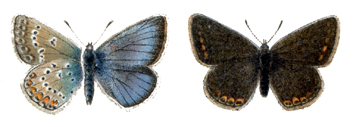
Polyommatus (ex Agrodiaetus, Plebicula, Lycaena) icarius Esper, 1789, syn amandus Schneider, 1792 [Lycaenidae]: a Palearctic blue with a wingspan of 30–35 mm, occurring in C, E, S and SE Europe, in Siberia and Mongolia. In Europe it is rather rare but common in S Siberian mountains. The males are a bright metallic blue, the females are brown with orange spots along the margins. The wingspan is 25–30 mm, the females are smaller.
Karges (1985) argued that Nabokov, using the old name 'amand-,' for some unknown reason had deliberately changed the gender, turning Amanda into Amandus. She was in error. Article 30 of the International Code of Zoological Nomenclature stipulates that if the specific name is an adjective, "it must agree in gender with the generic name with which it is at any time combined, and its termination must be changed, if necessary, when the species is transferred to another genus". So when the butterfly in question was in the genera Lycaena and Plebicula, it had to be amanda. When it was in Agrodiaetus, it had to be amandus. Amanda/us, of course, is an epithet signifying 'lovable'.
*Gift 133
& Ac: Polyómmatus/Agrodiáetus/Plebícula/Lycáena amándus • En: Amanda's Blue, Amandus Blue • Fr: l'azuré de la jarosse, (Don) amandus bleu • Ge: Prächtiger Bläuling • Ru: голубяпка милая, голубянка Аманда, (Dar) амандус • Sp: niña estriada
Polyommatus (ex Agrodiaetus, Plebicula, Lycaena) icarius isias Fruhstorfer, 1910 [Lycaenidae]: a valid subspecies of »Polyommatus icarius, the Amandus Blue, found by Fruhstorfer in the Sea Alps of S France .
*Lep4 266
Polyommatus icarus (Hübner 1793-1827)

Polyommatus (ex Plebejus, Lycaena) icarus Rottemburg, 1775 [Lycaenidae]: one of the commonest Palearctic blues, ranging from grassy areas of Europe across temperate Asia to the Pacific coast; it is also found in N Africa. The males are a bright violet-blue with a black border, the females are brown with orange spots along the margins. The wingspan is 25–30 mm, the females are smaller.
"It is very sensitive to climatic conditions; and seasonal forms cut across local ones in a most haphazard way. We can speak of racial tendencies rather than of true subspecies, and it is from this point that a number of the 'races' described by Verity should be viewed" (notes for "The Butterflies of Europe", 1964).
Polyommatus icarus was first described by Rottemburg in 1775 as Papilio icarus. As Hemming points out, Latreille who in 1804 established the genus Polyommatus and made icarus its type-species as well as other lepidopterists of his time seem to have confused icarus with Papilio (now: »Plebejus) argus Linnaeus, 1758.
As the type-species of the genus, icarus is something like the prototype of all the polyommatines (»Lycaenidae), the group of butterflies Nabokov did most of his scientific work on. This, of course, is not because icarus is more Polyommatus-like than all the others but for purely entomohistorical reasons.
In the Russian Lolita, the car on p. 254 of the English version is called an 'Ikarus'. In Ada, there is a car by the name of 'Argus'. Possibly these names for two cars are a reference to two particular shades of butterfly blue.
Between 1965 and 1971, Nabokov captured 55 specimens in Switzerland, France, Italy and Portugal.
The name 'polyommatus' means 'the many-eyed one'. The name refers to the many small ringed spots on the undersides of the wings.
*Lol 254; NabBut 208 (NB), 577 (BE), 609 (BE); Lep1 30; Lep2 257, 268; Lep4 267
& Ac: Polyómmatus ícarus • En: Common Blue • Fr: l'argus bleu commun • Ge: Hauhechelbläuling • Ru: голубянка Икар, (DarII) икар • Sp: ícaro, dos puntos
Polyommatus icarus flavocincta Rowland-Brown, 1909 [Lycaenidae]: a valid subspecies of the Common Blue occurring in Corsica.
*NabBut 610 (BE)
Polyommatus icarus var. septentrionalis Fuchs, 1900 [Lycaenidae]: a variety of the Common Blue occurring in N Norway (Bodø and Tromsø).
*NabBut 609 (BE)
Polyommatus meleager: »Polyommatus daphnis
Polyommatus polonus Zeller, 1844 [Lycaenidae]: a European blue that some authors believe to be either a natural hybrid of »Polyommatus coridon × »Polyommatus bellargus or extinct. The meaning of the cryptic line "Lysandra polonus Zell.= 'calydonius,' 'haffneri' etc (coridon × bellargus)" is that Nabokov believed the Polish Blue which had also been described under the more recent names calydonius and haffneri is a coridon × bellargus hybrid, like his own »Lysandra cormion turned out to be a coridon × daphnis hybrid. Zsolt Bálint is not convinced that this is so, for two reasons: (1) there have not been the necessary breeding experiments, (2) there is a constant population of Polyommatus polonus in Hungary ("Annotated list of type specimens of Polyommatus sensu Eliot of the Natural History Museum, London (Lepidoptera, Lycaenidae)", Neue entomologische Nachrichten [Marktleuthen], 46, November 1999, p. 1–89). However, the Distribution Atlas of Butterflies in Europe (2011) does not list it.
*NabBut 580 (BE)
Polyommatus (ex Kretania, Aricia, Lycaena) psylorita Freyer, 1852 [Lycaenidae]: a blue restricted to high mountains on the island of Crete, Greece. The males and females are brown, with red spots along the margins.
*N/WLet #127=106old
& Ac: Polyómmatus/Kretánia/Arícia/Lycáena psyloríta • En: Cretan Argus • Fr: l'argus crétois
Polyommatus (ex Cyaniris, Nomiades, Lycaena) semiargus Rottemburg, 1775 [Lycaenidae]: a blue with a wingspan of 25–30 mm flying in grassy, flowery and moist places in Morocco, Europe, Asia Minor to C Asia, N China, Korea, typically in the foothills.
*Lep1 30; Lep2 269; Lep9 48
& Ac: Polyómmatus/Cyaníris/Nomiádes/Lycáena semiárgus • En: Mazarine Blue • Fr: le demi-argus • Ge: Waldbläuling • Ru: голубянка бобовая, голубянка Семиаргус • Sp: falsa limbada
Polyommatus (ex Agrodiaetus, Plebicula, Lycaena) thersites Cantener, 1834 [Lycaenidae]: a purplish dark blue with a wingspan of about 30 mm, found in many parts of S and parts of C Europe. It is called 'Chapman's Blue' in English because the British entomologist Thomas A. Chapman in 1912 rescued it from oblivion. For almost a century since Cantener had described it as a distinct species, it had been treated as a mere form of the Common Blue (»Polyommatus icarus).
In "Nabokov's Butterflies", Godunov's father is said to have discovered its caterpillar.
*StrOps 60; NabBut 208 (FB); Lep2 268; Lep4 267
& Ac: Agrodiáetus/Plebícula/Lycáena thersítes • En: Chapman's Blue • Fr: l'azuré de l'esparcette • Ge: Burststeppen-Bläuling • Ru: голубянка Терзит, (DarII) терзит • Sp: celda limpia
Polyphemus Moth: »Antheraea polyphemus
Pontia Fabricius, 1807: a genus of »Pieridae, subfamily Pierinae (whites). The type-species is »Pontia daplidice, the Bath White.
*NabBut 586 (BE)
Pontia daplidice (Lampert 1907)
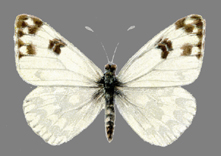
Pontia daplidice Linnaeus, 1758 [Pieridae]: a strongly migratory white with a wingspan of 35–45 mm and black marks on its white wings; their undersides are patterned predominantly a light green. Its range is N Africa and Canary Islands, SW Europe, Turkey, Middle East to Afghanistan and Kazakhstan. Sometimes it hazards way north of its habitual range. The form bellidice Hübner is the spring generation, flying in May; the name is not in use any more.
"…reaching N. to about Lat. 60° where it still breeds but is very rare: in twelve years collecting near St. Petersburg I took only one specimen, a small fresh male of the spring form, on the Oredezh R. in 1915…"
*StrOps 330; NabBut 586 (BE); Lep1 30; Lep2 268
& Ac: Póntia daplídice/bellídice • En: Bath White • Fr: le marbré de vert • Ge: Resedafalter • Ru: белянка Даплидика • Sp: blanquiverdosa
Pontia edusa Fabricius,
1777 [Pieridae]: an E European white morphologically indistinguishable from »Pontia daplidice but "biochemically distinct" (Tolman & Lewington, 1997). Karsholt & Razowski (1996) treat it as the "semispecies" of a superspecies Pontia daplidice. See also »Edusa Gold.Lol 29
& Ac: Póntia edúsa • En: Eastern Bath White • Fr: le marbré de Fabricius • Ru: белянка восточная
Pontia (ex Pieris) occidentalis Reakirt, 1866 [Pieridae], referred to by Nabokov as 'Pieris' callidice occidentalis Reak.: one of the butterflies encountered by Nabokov in August, 1949, at Jackson Hole. Pontia occidentalis is a N American white similar to the Palaearctic Pontia callidice Hübner, 1799 of the Pyrenees, the Alps, Asia Minor, Tibet, the Himalayas and Mongolia. It is unclear how the two species are related and if the American one should be considered a subspecies of the Old World one; the prevailing opinion seems to be that it is a species of its own. Its range is Alaska to Manitoba and south to C California and New Mexico.
*Lep16
& Ac: Póntia callídice • En: Peak White • Fr: le veiné-de-vert, le marbré des alpages • Ge: Alpenweißling • Sp: blanquiverdosa alpina
& Ac: Póntia/Píeris (callídice) occidentális • Am: Western (Chequered) White
Poplar Admirable: »Limenitis populi
processionary moth: »Thaumetopoea
Proclossiana (ex Boloria) eunomia alticola Barnes & McDunnough, 1913 [Nymphalidae, Heliconiinae, Argynnini]: the Ocellate Bog Fritillary, described from Hall Valley, Colorado.
*StrOps 323
Proclossiana (ex Boloria) eunomia eunomia ESPER, 1800 [Nymphalidae, Heliconiinae, Argynnini]: a holarctic fritillary with a wingspan of 38 mm, flying in Europe, Russia, Mongolia, NE China, Sakhalin and N America. It is the type-species of the genus Proclossiana. The butterfly had originally been described under Papilio aphirape HÜBNER, 1799-1800, and aphirape has lingered on into the 20th century; it is no valid specific or subspecific name.
& Ac: Proclossiána eunómia • En: Ocellate Bog Fritillary • Ge: Randring-Perlmutterfalter • Fr: le Nacré de la bistorte
*LtVé 97
Pronuba: »Tegeticula yuccasella
Proterebia (ex Erebia) afra Fabricius, 1787, syn afer Esper, 1783, phegea Borkhausen, 1788 [Nymphalidae, Satyrinae, Erebiini]: the Dalmatian Ringlet, in Dalmatia, S Russia, Asia Minor, S Urals, Caucasus, Kazakhstan. "A prairie insect dancing in and out of the grass of southern Russian steppes locally in great numbers (i.e. on the Yayla plateau in the Crimea in June)".
*NabBut 593 (BE); Lep1 32
Pseudochazara euxina (Tuzov e.a. 1997)
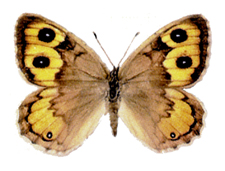
Pseudochazara (ex Hipparchia) euxina Kusnezov, 1909 [Nymphalidae, Satyrinae, Satyrini]: In Nabokov's first entomological paper (Lep1) listing the 77 species he had collected in the Crimea between November 1917 and August 1918, there are thirteen satyrines, but Hipparchia euxina is not among them. He noted: "I was disappointed in not finding H. euxinus – a new species lately described by Kuznetzoff". Nikolai Yakovlevich »Kuznetsov's paper had appeared in Ezhegodnik zoologicheskago museya Imperatorskoi Akademii Nauk (Yearbook of the Zoological Museum of the Imperial Academy of Sciences, St. Petersburg, vol. 14, 1909, p. 140–144) under the title "A new species of Hipparchia Fabr. 1807 (Satyrus Latr. 1809) from the Crimea". Kuznetsov compared his find to the Hippolyte Grayling [»Pseudochazara hippolyte] to which it is so similar that he thought it might rate only as a subspecies of it: "On the upperside: ground colour more saturated brown without transparent markings from below; colour of the fasciae sharply contrasting and more pure orange-yellow, with straight, not lunulate margins of the fasciae of both wings …" Today Pseudochazara euxina is considered a species, not a subspecies.
The butterfly occurs on the S coast of the Crimea at elevations between 500 and 1,200 m, especially "on the southern rocky slopes of Ai-Petri" – which is excatly where Nabokov had hunted butterflies himself without encountering this one.
Perhaps to make up for his bad luck, Nabokov had Godunov Senior show his son in the spring of 1915 "among the rocks of Ai-Petri and on the grassy plateau of the Yaila …, with a smile of condescension for this European trifle, the satyrid recently described by Kuznetsov, which was flitting from stone to stone" (p. 129). The smile of condescension may be explained not so much by the fact that Godunov on his travels in C Asia was used to rarer and more spectacular insects but that he had seen this very one before in C Asia. Indeed, Kuznetsov noted that the closest allies of the Crimean form are "the specimens from Lob-Nor in Central Asia," one of Godunov's true hunting grounds.
In Speak, Memory (p. 247) – only in the revised version of 1966 – Nabokov remembers trudging along a mountain path in the Crimea "with my butterfly net, toward the upper crags where the Euxine race of the Hippolyte Grayling was expecting me". Perhaps it was expecting him, but he did not find it; what he found "at the very summit of Ai-Petri", according to Lep1, were a few specimens of Hipparchia hippolyte but not the race euxina: "Gently flutters among the rocks, often settling with closed wings on the ground."
From the notes for "The Butterflies of Europe": "The most interesting member of the meager Crimean butterfly fauna. Rocky escarpments topping the pine-clad slopes of the Yayla mountains on the southern coast are its favorite haunts. It flies for brief indolent spells frequently on the ground and on rocks..."
Professor K.A. Efetov of Simferopol thinks Nabokov did find it in the Crimea but did not recognize it, mistaking the butterfly he collected on "July 13th, at the very summit of Ai-Petri," for a Pseudochazara hippolyte: "It is completely clear that Nabokov collected Pseudochazara euxina and not Pseudochazara hippolyte. Pseudochazara euxina has been described from the mountain Ay-Petri (type-locality) and is on the wing in July. I collected this species myself on Ay-Petri many times. Pseudochazara hippolyte is very similar to Pseudochazara euxina in habitus, but absent in the Crimea" (personal communication).
Pontus Euxinus was the Latin name of the Black Sea. 'Euxina' means 'from the Black Sea region'. In Autres Rivages, the butterfly is rendered as "le Pseudochazara Hippolyte de la race turque".
*Gift 129; NabBut 589 (BE); Lep1 32
& Ac: Pseudochazára/Hippárchia euxína • En: *Black Sea Grayling • Ge: *Schwarzmeer-Samtfalter • Ru: сатир черноморский
(name coined in 1999 by Konstantin Efetov)
Pseudochazara (ex Hipparchia) hippolyte Esper, 1784 [Nymphalidae, Satyrinae, Satyrini]: a butterfly quite similar to »Hipparchia semele with a wingspan of about 48 mm and a pale gray-brown upperside with broad straw-colored bands and two small eyespots on the forewings and one on the hindwings. Its distribution is remarkable. The type specimen was taken in the eighteenth century near Orenburg in S Russia, and Nabokov believed he had taken a few specimens in the Crimea. While it is absent from the rest of Europe, an isolated colony was found in the Sierra Nevada of S Spain for which it is commonly called Nevada Grayling. It also occurs in Asia Minor and east to the Tianshan mountains of C Asia. So this butterfly seems to unexpectedly connect Nabokov's Russian past with his West European one and also with the travels to Central Asia he was dreaming about.
*SpeakM 247; Lep1 32
& Ac: Pseudochazára/Hippárchia hippólyte • En: Hippolyte Grayling, Nevada Grayling • l'ocellé andalou • Ge: *Sierra-Nevada-Samtfalter • Sp: filabresa
Pseudochrysops Nabokov, 1945 [Lycaenidae, Polyommatinae, Polyommatini, Pseudochrysops Section]: a new genus of Neotropical »Lycaenidae introduced by Nabokov. The type-species is »Pseudochrysops bornoi. See in »Section 1.
*Lep9 12–14, 47, passim
Pseudochrysops bornoi Comstock & Huntington, 1943 [Lycaenidae]: a blue in Haiti, the type-species of the genus »Pseudochrysops Nabokov, 1945.
*Lep9 12–14
Pseudodemas tschumarae: This seems to be an altogether imaginary lepidopteron. It serves Godunov jun. to prove that the "utilitarian" theory of protective mimicry (and hence the theory of natural selection) is "illusory".
Godunov jun. reports the case of Pseudodemas tschumarae, a "quite local Siberian owlet moth" said to imitate the downy yellow flowers of the scrub Tschumara vitimensis. So far, the case would be an altogether normal one. When an insect tries to be less conspicuous to potential predators by blending into the background, biologists speak of 'crypsis'. Most caterpillars (which are otherwise defenseless) practice some kind of crypsis.
However, the present case would be a case of anachronistic crypsis, because the flowers bloom in May while the caterpillar of the moth appears only at summer's end. The camouflage actually makes it not less but more conspicuous and hence is of no use to it. "The happy impression of enchanting irrationality experienced by the observer at the sight of a disguised tschumarae – an imaginary flower, an impossible flower – that is what nature, our intelligent accomplice and witty mother wanted to achieve, and did."
There does not seem to be a plant by the name of Tschumara vitimensis (or chumara, tchumara, etc.). However, in the book he wrote on his fourth expedition into Central Asia in 1879-80 (Iz Zaisana cherez Khami v Tibet i na verkove Zheltoi reki, 1883, ch. 17), Nikolai Przhevalskii several times mentions Dzhuma, the Tangut name for the common European and Asian herb Silverweed or Cinquefoil (Potentilla anserina L.). It blooms in spring and has yellow flowers. If Nabokov invented the plant and its name, he may have been influenced by Przhevalski's book which he seems to have studied before writing The Gift, making the plant the Dzhuma of Chumara, so to speak. Chumara is a locality some 1200 km SE of Moscow in the Republic of Bashkortostan. Tschumara vitimensis then would be the Vitim variety of the Silverweed plant first described from Chumara in the E of European Russia, while Vitim in its turn is a town on the Lena River some 500 km E of Lake Baikal. The name vitimensis has been used at least three times for local Siberian butterflies; they all are obsolete. (These butterflies are Brenthis ino paidicus Fruhstorfer, 1907, Colias tyche Böber, 1812, Pieris euorientis Verity, 1908.) So geographically, the case can more or less be pinned down.
Also there certainly is no genus of Lepidoptera by the name of Pseudodemas. No such moth exists in the collections where it would belong, in the Siberian Museum of Zoology in Novosibirsk. However, the name helps to localize Pseudodemas ('the false fat one') in the subfamily Pantheinae of the noctuids. There is, or rather was, the generic name Demas Stephens, 1828, an obsolete synonym of what today is Colocasia Ochsenheimer, 1816; the type species is Colocasia coryli Linnaeus, 1758, the Nut-tree Tussock Moth. A Pseudodemas would be an insect that looks like a Demas but is none.
I do not know whether there is a case of anachronistic crypsis like that of 'tschumarae,' and if there is, whether it is meant to be a disguise at all. The caterpillars of noctuids for the most part are small and inconspicuous. Living close to the ground among grasses and herbs, they usually are mottled brown, gray, black – earthy colors with sometimes a bit of green or yellow. But even if such a case existed, it would be a very weak one to base a refutation of Darwinism on. The yellow color might be useful to the caterpillar even out of season, in case the local birds find a tidbit that looks like a flower not too appetizing at any time of the year.
There is a butterfly whose larvae are as yellow as the flowers of the plants it feeds on. It is Phoebis sennae Linnaeus, 1758 [Pieridae], the Cloudless Giant Sulphur, a lemon-yellow butterfly (wingspan 41–70 mm) on open and brushy land, from S California and Gulf States, Mexico and C America to Patagonia. The mature larva (41–44 mm) is a mustard yellow with rows of black dots across the back. Among other plants, it lives on many kinds of senna (Cassia), hiding in day tents made of silk and leaves. They are "extremely difficult to spot on their Cassia foodplant, especially as they usually feed amongst the yellow flowers" (Preston-Mafham 1988, p. 97). There is no hint, however, that the color is out of sync with the flowers.
*NabBut 222–223 (FB)
& Ac: Colocásia córyli • En: Nut-tree Tussock • Ge: Haseleule • Ru: узорница лещинная
Pseudolucia Nabokov, 1945 [Lycaenidae]: a genus of Neotropical »Lycaenidae named by Nabokov (subfamily Polyommatinae, tribe Polyommatini, Polyommatus section). The type-species is Pseudolucia chilensis Blanchard, 1852 (see in »Section 1).
*Lep9 32–36, 47
Pseudolucia chilensis Blanchard, 1852 [Lycaenidae]: a blue in Chile, the type-species of the genus Pseudolucia Nabokov, 1945 (see in »Section 1).
*Lep9 33–34
Pseudolucia collina (Peña Guzman 1997)
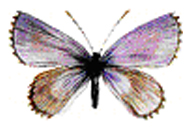
Pseudolucia collina Philippi, 1859 [Lycaenidae]: the Pale Blue Hairstreak, Spanish licena celeste, a blue of the »Polyommatus Section, in the coastal region, the subcoastal mountains and the High Andes of C Chile.
*SelLet 55; Lep9 34–36
Pseudophilotes baton (Hofmann 1894)

*Pseudophilotes (ex Philotes, Scolitantides, Lycaena) baton Bergsträsser, 1779 [Lycaenidae, Polyommatinae, Polyommatini, Glaucopsyche Section]: this could be one of the "small blue butterflies settling on thyme" of Despair. It is a Palearctic blue ranging from Spain to Afghanistan, specialized on thyme as a foodplant; the caterpillars feed on it, the adults like to settle on its flowers.
*Despair 38; Lep2 257, 270
& Ac: Pseudophilótes/Philótes/Scolitantídes/Lycáena báton • En: Baton Blue • Fr: l'azuré de la sarriette • Ge: Graublauer Bläuling, Quendel-Bläuling • Sp: falso abencerraje
Pseudophilotes (ex Philotes, Lycaena) baton albonotata de Sagarra, 1926 [Lycaenidae, Polyommatinae, Polyommatini, Glaucopsyche Section]: a subspecies (or variety?) of the Baton Blue (»Pseudophilotes baton), in Castilia, Toledo, Cuenca, Zaragossa, Catalonia and the E Pyrenees.
*Lep2 257
Pseudophilotes (ex Scolitantides) baton Bergsträsser, 1779, var. clara [Lycaenidae, Polyommatinae, Polyommatini, Glaucopsyche Section]: a local Russian variety of the Baton Blue. Nabokov says he found it abundantly in some places in the Crimea.
*Lep1 30
Pseudotergumia fidia Linnaeus, 1767 [Nymphalidae, Satyrinae, Satyrini]: the Striped Grayling, widespread but local in N Africa and SW Europe. It resembles Freyer's Grayling (»Neohipparchia fatua).
*NabBut 589 (BE)
Pseudothecla Nabokov, 1945 [Lycaenidae]: the name of a new genus of Neotropical »Lycaenidae introduced by Nabokov. The type-species was Pseudothecla faga Dognin, 1895. The name turned out to be a homonym and had to be cancelled. It was replaced by »Nabokovia by »Hemming.
*Lep9 11, 33, 47
Pterogon gorgoniades: »Sphingonaepiopsis gorgoniades
Ptilocephala (ex Oreopsyche) muscella Denis & Schiffermüller, 1775 [Psychidae]: a bagworm moth in W and C Europe, flying at dawn. "Looking like big dark flies."
*Lep2 257
pug, pug moth: any of several small geometer moths of the genera »Eupithecia Curtis, 1825 and Chloroclystis Hübner, 1825.
*SpeakM 136
pulla: »Epichnopteryx pulla
Purple Emperor: »Apatura iris
Puss Moth: »Cerura vinula
Pyrameis Hübner, 1819: an abandoned genus of »Nymphalidae, subfamily Nymphalinae, tribe Nymphalini (anglewings). The type-species was atalanta Linnaeus, 1758. As a junior synonym of »Vanessa Fabricius, 1807, the name Pyrameis was abandoned.
The species Godunov jun. called central to the genus is Vanessa indica Herbst, 1794, the Indian Red Admiral, in Sri Lanka, S India, NE India, Kashmir, Himalayas, Myanmar. It is similar to the European Red Admiral (»Vanessa atalanta), but the central red band on the forewings is wider and divided by three black spots. The cryptic underside is similar to that of the Painted Lady (»Vanessa cardui) but without a row of eyespots. Godunov may have considered it central to the genus because its relationship to atalanta is as clear as that to cardui.
*NabBut 232 (FB), 596 (BE)
Pyrameis atalanta: »Vanessa atalanta
Pyrameis cardui: »Vanessa cardui
Pyrgus Hübner, 1819: a genus of »Hesperiidae (skippers), subfamily Pyrginae (pyrgine skippers). The type-species is Pyrgus alveolus Hübner, 1803. The pyrgine skippers are very hard to distinguish without close inspection and comparison.
*NabBut 577 (BE)
Pyrgus (ex Hesperia) alveus Hübner, 1803 [Hesperiidae]: a pyrgine skipper, wingspan 30 mm, in N Africa, Europe, Asia Minor, S and W Siberia, Urals, Mongolia, N China.
*Lep1 29; LtVé 423
& Ac: Hespéria/Pýrgus alvéus • En: Large Grizzled Skipper • Fr: le Plain-chant • Ge: Sonnenröschen-Würfelfalter • Ru: толстоголовка лапчатковая • Sp: ajedrezada serrana
Pyrgus (ex Hesperia, Ataleomorpha) armoricanus Oberthür, 1910 [Hesperidae]: a pyrgine skipper of N Africa, C and S Europe, Turkey, S Urals. The wingspan is 27 mm. "I took one specimen in 1913 or 1914."
*NabBut 611 (BE); Lep2 269; LtVé 423
& Ac: Hespéria/Pýrgus armoricánus • En: Oberthür's Grizzled Skipper • Fr: l'Hespérie des potentilles • Ge: Zweibrütiger Würfelfalter • Ru: толстоголовка земляничная/суницева • Sp: ajedrezada yunque
Pyrgus carthami (Lampert 1907)
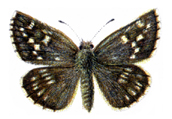
Pyrgus (ex Hesperia, Scelotrix) carthami Hübner, 1813, syn fritillarius auct. [Hesperiidae]: a pyrgine skipper of SW and C Europe, Balkans, S Russia, C Asia. Wingspan 32 mm. "Smallish, but I took a gigantic individual at Moulinet …"
*NabBut 611 (BE); Lep1 29
& Ac: Pýrgus/Hespéria fritillárius/cárthami • En: Safflower Skipper • Fr: l'Hespérie du carthame • Ge: Dunkelbrauner Dickkopffalter, Weißgesäumter Würfelfalter • Ru: толстоголовка алтейная
Pyrgus centaureae Rambur, 1839 [Hesperiidae]: the Northern Grizzled Skipper, along the N of Europe, America and Asia, also in the Altai, described from Lapland.
*StrOps 316
Pyrgus centaureae freija Warren, 1924 [Hesperiidae], Freija's Grizzled Skipper, misspelt Pargus in Strong Opinions (p. 325), a subspecies of »Pyrgus centaureae, the Northern Grizzled Skipper.
*StrOps 325; Lep16
Pyrgus (ex Hesperia) communis Grote, 1872 [Hesperiidae]: the Common Checkerspot or Chequered Skipper, from Canada to S America.
*StrOps 327
Pyrgus foulquieri OBERTHÜR, 1910 [Hesperiidae], invalid syn bellieri OBERTHÜR, 1910: a skipper, wingspan 28 mm, in SE France and locally in Catalonia and C Italy.
& En: Foulquier's Grizzled Skipper • Fr: l'Hespérie des hélianthèmes • Ge: *Foulquiers Würfelfalter
* LtVé 423
Pyrgus maculatus Bremer & Grey, 1853 [Hesperiidae]: the "blotched skipper," in S Siberia, Ussuri, Japan.
*Lep3 222
Pyrgus malvae (Lampert 1907)
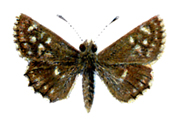
Pyrgus (ex Carcharodus) malvae Linnaeus, 1758, syn althaeae Esper, 1783, sao Bergsträsser, 1779 [Hesperiidae]: the Grizzled Skipper, in Europe, Turkey, Tianshan, Mongolia, N China, Korea.
Pyrgus malvae graeca Oberthür, 1907 is either a subspecies or a local form in Greece.
*Lep1 29; Lep2 268; Lep3 222
& Ac: Hespéria/Pýrgus málvae/althéae/sáo • En: Grizzled Skipper • Fr: l'hespérie de la mauve • Ge: Malvenwürfelfalter • Ru: толстоголовка мальвовая, малая мальвовая толстоголовка
Pyrgus (ex Hesperia) malvae malvoides Elwes & Edwards, 1897 [Hesperiidae]: a S European subspecies of the Grizzled Skipper. Pyrgus malvae malvoides ab. tutti Verity, 1918 is an aberrational form described from Locarno, taxonomically without standing.
*NabBut 622 (L), Lep2 257, 268
Pyrgus (ex Hesperia) onopordi Rambur, 1839 [Hesperiidae]: a skipper in Morocco, Algeria, SW Europe.
*Lep2 269
& Ac: Hespéria/Pýrgus onopórdi • En: Rosy Grizzled Skipper • Fr: l'hespéride de la malope • Ge: Ambossfleck-Würfelfalter • Sp: ajedrezada bigonia
Pyrgus orbifer: »Spialia orbifer
Pyrgus protheon: »Muschampia proto
Pyrgus (ex Hesperia) serratulae Rambur, 1839 [Hesperiidae]: the Olive Skipper, in the Iberian Peninsula, SE France, Switzerland, S Germany, Asia Minor, Armenia.
*Lep2 268
& Ac: Hespéria/Pýrgus serrátulae • En: Olive Skipper • Fr: l'hespérie de l'alchémille • Ge: Schwarzbrauner Würfelfalter, Rundfleckiger Würfelfalter
Pyrgus sao: »Pyrgus malvae
Pyronia bathseba Fabricius, 1793, hom pasiphae Esper, 1781 [Nymphalidae, Satyrinae, Maniolini]: a widespread and locally common satyr (grayling) of NW Africa and SW Europe. "I have found it fairly common near Toulon in mid-May 1923. It prefers shady nooks and settles with open wings on the leaves of shrubs …"
*NabBut 589 (BE)
& Ac: Pyrónia báthseba • En: Spanish Gatekepper • Fr: le tityre • Sp: lobito listado